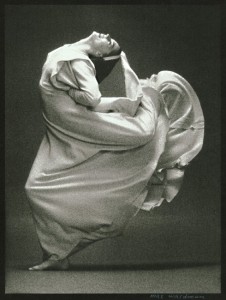Martha Graham, “Frontier” (1935)
![]() Guide: Modern Dance in America
Guide: Modern Dance in America
DANCE IN PROFILE: Martha Graham, Frontier (1935)
Watch the video on YouTube with an introduction by Martha Graham. (Performance filmed 1976. Danced by Janet Eilber.)
Choreography and costume design by Martha Graham.
Music by Louis Horst.
Set design by Isamu Noguchi.
Frontier is a relatively early work by Martha Graham, created less than a decade after she began dancing on her own after leaving the Denishawn School, where she danced under the instruction of Ted Shawn. During this early period (roughly 1926-1938) she focused on creating solo dances for herself to perform, before developing the theatrical group dances of the 1940s that would define her later career and secure her popularity (such as Night Journey, which depicts a scene from Oedipus Rex, and Appalachian Spring, which depicts an original story of a pioneering husband and bride.)
This beautiful dance embodies some of the major themes and creative methods developed in her early works that would continue to factor into work for years to come, including:
- Close collaborations with designers and composers to develop a cohesive atmosphere. Graham worked with sculptor Isamu Noguchi and composer Louis Horst on Frontier. They were both important ongoing collaborators for her (particularly Horst, who was her teacher, advocate, lover, and collaborator for many years). It has been said that in her collaborations, Graham was always the director. In this context, she believed the other art forms should ultimately serve the vision of the dance.
- Exploration of national identity through the eyes of archetypal characters from history. In this dance, a pioneer woman surveys a vast Western landscape (suggested by the sparseness and broadness of Noguchi’s minimalist set). The dancer is a representation of Western expansion: Americans’ progress into the unknown and their hunger for space. As always, Graham imbues this generic woman with a remarkably intimate emotional expression and individual identity. This piece foreshadows the Pennsylvanian pioneers of Appalachian Spring (1944).
- The use of costume to evoke a setting, to imply a character, and to complement the dance vocabulary. In Frontier, the dancer wears the long-skirted dress closely identified with Graham’s costume designs (she always designed the costumes for her own works). In this case, the dress also refers to the style of dress of 19th century pioneer women. The light pink hue—colors were carefully considered by Graham—suggests optimism and freshness.
In Graham’s method, the contraction and release of the torso (a motion organically derived from the act of breathing) is the center from which all of her sweeping, expressive movements extend. The dress accentuates the movements of the dancer, particularly by elongating the motion of her limbs.
- The use of the floor as a plane for expressive movement. Graham was intentionally anti-ballet and anti-establishment, and one of the many ways in which she radically broke from ballet aesthetics was the use—rather than the denial—of gravity. (In this, she was apparently influenced by some avante garde German dance.) She often danced while sitting, or fell gracefully onto the ground.
Check out this quotation from Graham’s autobiography Blood Memory:
The designs that Isamu brought to Frontier came from our discussion of the hold the frontier had always had on me as an American, as a symbol of a journey into the unknown. Traveling to California by train, the endless tracks were to me a reiteration of that frontier.
When at last I asked Isamu for an image of them in my dance, he brought to me the tracks, as endless ropes into the future.
(…)
I had the idea of Frontier in my mind as a frontier of exploration. a frontier of discovery, and not one of limitation.(…) It makes me triumphant to think that nothing lasts but the spirit of man and the union of man. People cross the border from East to West to shake the hands of those they have not seen before. In a way, they have become each others’ frontier.
Here are images of Graham performing this piece in 1935:
http://www.flickr.com/photos/haggertymuseum/5269091334/
http://www.flickr.com/photos/haggertymuseum/5264120495/
http://www.flickr.com/photos/haggertymuseum/5268683563/
http://www.flickr.com/photos/haggertymuseum/5269295392/
I consulted these sources in researching Graham’s work:
Mazo, Joseph H. Prime Movers: The Makers of Modern Dance in America. Princeton, 2000.
Reynolds, Nancy, and Malcolm McCormick. No Fixed Points: Dance in the Twentieth Century. Yale UP, 2003.
